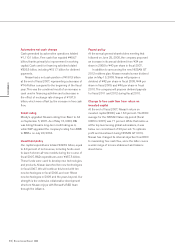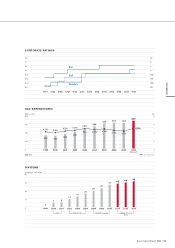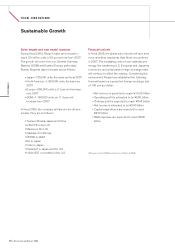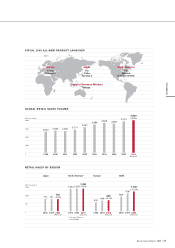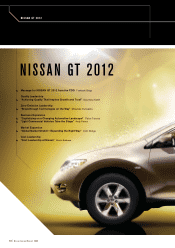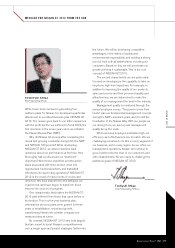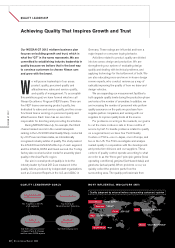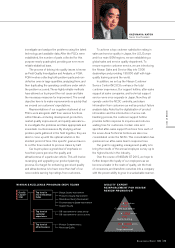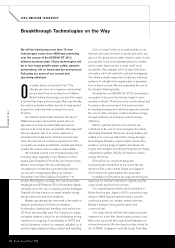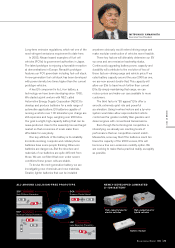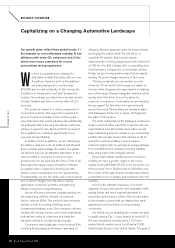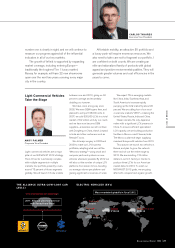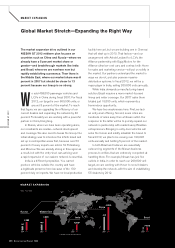Nissan 2008 Annual Report Download - page 25
Download and view the complete annual report
Please find page 25 of the 2008 Nissan annual report below. You can navigate through the pages in the report by either clicking on the pages listed below, or by using the keyword search tool below to find specific information within the annual report.
NISSAN EXCELLENCE PROGRAM (NEP) TEAMS QUALITY EXPERT
REINFORCEMENT FOR DESIGN
REVIEW PROMOTION
Quality
Leader-
ship
Top level in
more influential
Index
Top level of
customer
experience
Top level of
attractiveness
Design Quality Improvement
Production Quality Improvement
Break-down Quality Improvement
Countermeasure Speed Improvement
Supplier Quality
CS improvement for sales activity
CS improvement for service activity
Product Competitiveness
Perceived Quality
250 4,300persons
Crew
Design review staff
51,000persons
Pilot
Quality coaching
250persons
Expert
Complex issue solution
23
Nissan Annual Report 2008
NISSAN GT 2012
KAZUMASA KATOH
Senior Vice President
investigate and analyze the problems using the latest
technology and available data. After the FQCs were
established, the number of parts collected for this
purpose nearly quadrupled, providing an even more
reliable statistical base.
The process of delving into quality issues is known
as Field Quality Investigation and Analysis, or FQIA.
FQIA involves collecting both problem parts and non-
defective ones in large quantities, analyzing them, and
then duplicating the operating conditions under which
the problem occurred. These highly reliable methods
have allowed us to pinpoint the root cause and take
the necessary measures for improvement. The overall
objective here is to make improvements so quickly that
we exceed our customers’ expectations.
Representatives of our suppliers stationed at our
FQCs work alongside staff from various functions
within Nissan—including development, production,
market quality improvement, and quality assurance—
to investigate the problems and take appropriate and
immediate countermeasures. By studying actual
problem parts gathered in the field together, they are
able to come up with the optimal solution in the
shortest period of time. One specific goal we have is
to cut the time needed to process claims by half.
Car buyers place a great deal of emphasis on
how their peers perceive the quality and
attractiveness of a particular vehicle. This will involve
revamping and upgrading our product planning
process. Our target for enhancing perceived quality
and attractiveness is to have more than half of our
new models earning top ratings from customers.
To achieve a top customer satisfaction rating in
sales and service quality in Japan, the U.S., Europe
and four main GOM regions, we are establishing a
global sales and service quality department. To
ensure superior customer service, we are introducing
the Nissan Sales and Service Way into 7,000
dealerships and providing 130,000 staff with high-
quality training around the world.
In addition, we set up the Nissan Customer
Service Center (NCSC) to enhance the total
customer experience. Our support hotline, after-sales
support at sales companies, and technical support
service were once separate in Japan. Now they all
operate under the NCSC umbrella, and share
information from customers as well as product failure
analysis data. Aided by the digitalization of product
information and the introduction of a new call-
handling process, the customer support hotline
provides better response to inquiries and reduces
waiting time for customers. Certain roles and
specified after-sales support functions from each of
the seven Area Technical Centers are also now
consolidated under the NCSC. This consolidation has
quickened our after-sales team’s response time.
Our goal for upgrading management quality is to
bring the results of the annual employee survey up to
the highest levels in the industry.
Over the course of NISSAN GT 2012, we hope to
further deepen the loyalty of our employees as we
become a leader in the realm of quality, win the trust
of consumers, and transform ourselves into a company
with the proven ability to grow in a sustainable manner.



